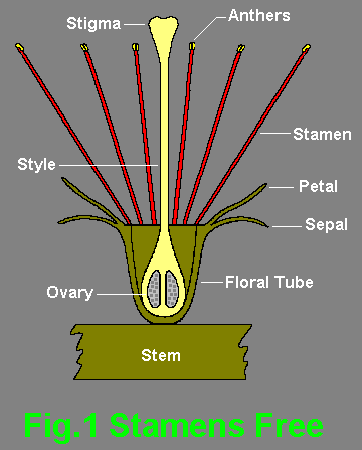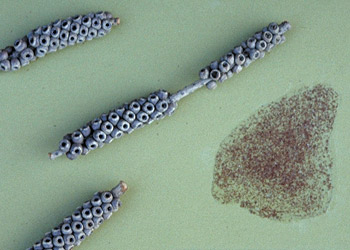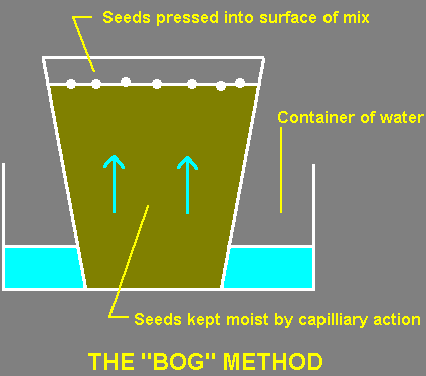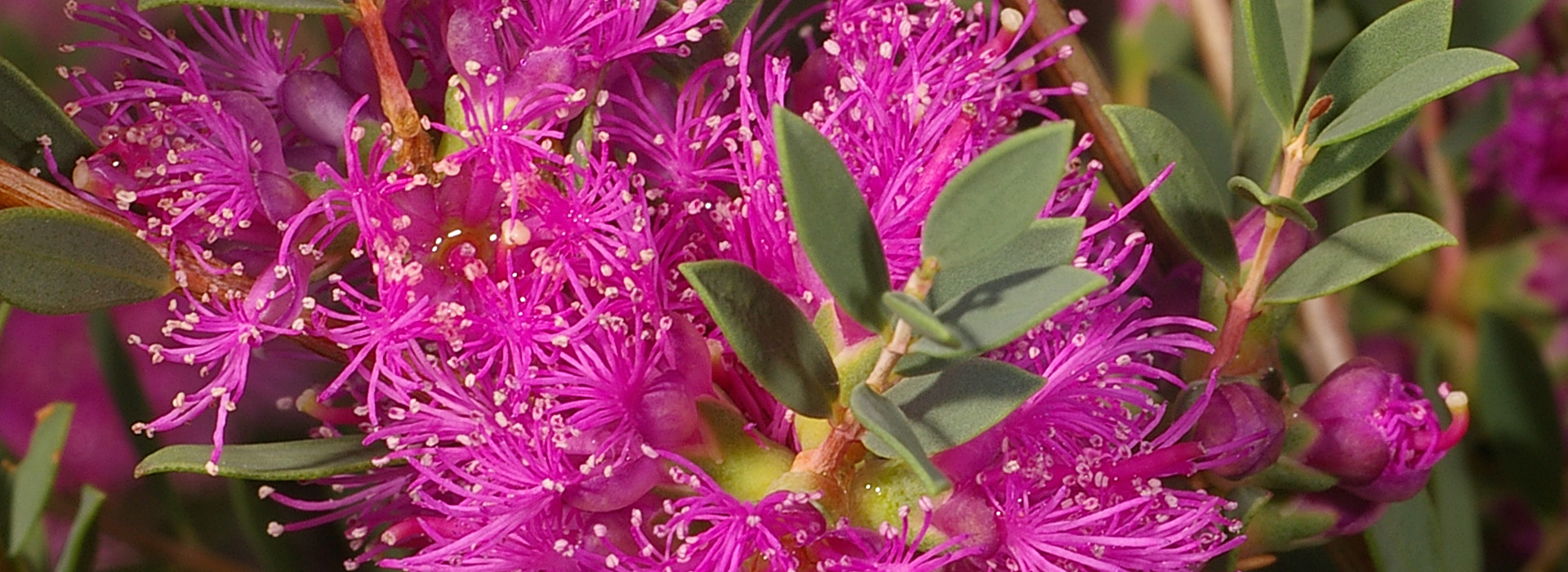Melaleuca – Background
Introduction
Melaleuca is a genus of around 170 species in the Myrtle family (Myrtaceae). However, there are many unnamed and incorrectly named species and the true number is probably well in excess of 200. The majority of species are endemic to Australia but several occur to the north (eg. Indonesia, New Guinea, New Caledonia, Malaysia). The first plants of the genus were, in fact, collected in the mid 1600s in Indonesia by George Runf, a Dutch merchant. These two species are now known as M.leucadendra and M.cajuputi and both also occur in tropical Australia.
Melaleucas are commonly known as “Paperbarks” in the tree forms and “Honey Myrtles” in the smaller forms. These names refer to the flaky bark of many species and the nectar produced in the flowers. The term “Tea Tree” is also applied occasionally by this is more commonly used with the related genus Leptospermum.
The botanical name for the genus means “black and white” and presumably refers to the blackened lower bark and white upper bark of some species, resulting from fire.
Melaleuca is closely related to Callistemon (“Bottlebrushes”) and differs from that genus in the way that the stamens are connected to the floral tube. The stamens are generally free in Callistemon but united into bundles in Melaleuca (see also information under the “Melaleuca and Callistemon; Why are they Different?” tab).
In nature, melaleucas are often found along watercourses or along the edges of swamps. They are generally plants of open forest, woodland or shrubland and are popular for gardens and landscaping both in Australia and overseas. With one exception, melaleucas have not become weeds outside of their natural habitat. M.quinquenervia, however, a large tree from eastern Australia, has become a serious pest in the Florida everglades in the USA. This particular species is widely used as a landscaping plant in many parts of Australia.
Characteristics
The showy parts of the flowers of Melaleuca are the stamens, the petals being small and inconspicuous. The stamens are often brightly coloured with red, pink, mauve, purple and yellow being common. The Melaleuca “flower” is really an inflorescence formed by a cluster of small flowers.
Peak flowering for most species is spring (September to November in Australia), however, a spasmodic flowering at other times is not unusual. The flower clusters may occur terminally at the ends of branches or in short spikes along the branches.
Following flowering, three-celled woody seed capsules develop with each capsule containing many small seeds. The seed pods usually remain tightly closed unless stimulated to open by fire or by the death of the plant.
Most melaleucas are small to medium shrubs but a few can become medium to large sized trees.
Commercial Applications
Very few species of Melaleuca have commercial uses. The timber of M.leucadendra and M.quinquenervia has been used for fairly minor applications such as railway sleepers, fence posts and mine props and these species are also useful in honey production.
The most significant use of the genus is in the production of Tea Tree Oil. M.alternifolia is most commonly used species and there has been significant expansion of the industry in the past decade or so. Tea Tree Oil is particularly valuable as a germicide and is used in a number of products including shampoos, antiseptic creams and soaps (further information can be found under the “Tea tree Alternative” tab).
Goodbye Callistemon?
The problem with the classification of Callistemon and Melaleuca on the basis of the arrangement of the stamens is that this supposed difference is not clear cut and Callistemon tends to merge into Melaleuca rather than being unambiguously distinct. The well known Callistemon viminalis is one that has often been discussed as not easily fitting the accepted definition of Callistemon.
Over the years there have been suggestions that the differences between species of the two genera are not sufficient to warrant them being kept distinct. A paper by Lyn Craven of the Australian National Herbarium (Novon 16 468-475; December 2006 “New Combinations in Melaleuca for Australian Species of Callistemon (Myrtaceae)“) argues that the differences between the two genera are insufficient to warrant them being retained separately and that they should be combined. As Melaleuca has precedence, adoption of Craven’s work would transfer all species of Callistemon into Melaleuca. Some state herbaria have adopted this change but, at this stage, the re-classification has not been taken up in the Australian Plant Census, which ANPSA recognises as the authority on plant nomenclature. For this reason we have retained Callistemon and Melaleuca as separate genera.
Craven’s re-classification has been adopted in a recent (2013) publication “Melaleucas: their botany, essential oils and uses” by Joseph J. Brophy, Lyndley A. Craven and John C. Doran.
Melaleuca and Callistemon: Why are they Different?
Melaleuca and Callistemon are two of the best known Australian members of the Myrtle family. All of the Callistemons and many of the Melaleucas have flowers arranged in “Bottlebrush” fashion clustered together in cylindrically shaped spikes. But only Callistemons are commonly called “Bottlebrushes” ; Melaleucas are usually called “Paperbarks” or “Honey Myrtles” or sometimes “Tea Trees” although that name is more appropriate to another related genus, Leptospermum.
So what makes Melaleuca and Callistemon different?
The main difference has to do with the way in which the stamens (the male parts of the flowers) join to the floral tube. Figure 1 shows a cross section of a single Callistemon flower. This shows that each stamen joins the floral tube independently of every other stamen (this is referred to as the stamens being “free”).

In Figure 2, however, which is a cross section of a single Melaleuca flower, the stamens are joined together into groups with each group joining the floral tube as a unit (this is referred to as the stamens being “united”). Each Melaleuca flower contains five of these groups or “staminal bundles”.
In most cases this difference can be easily seen by examining the flowers with the naked eye. However, the problem with the current classification on the basis of the arrangement of the stamens is that this supposed difference is not clear cut and Callistemon tends to merge into Melaleuca rather than being unambiguously distinct. The well known Callistemon viminalis is one that has often been discussed as not easily fitting the accepted definition of Callistemon.
Over the years there have been suggestions that the differences between species of the two genera are not sufficient to warrant them being kept distinct. A paper by Lyn Craven of the Australian National Herbarium (Novon 16 468-475; December 2006 “New Combinations in Melaleuca for Australian Species of Callistemon (Myrtaceae)”) argues that the differences between the two genera are insufficient to warrant them being retained separately and that they should be combined. As Melaleuca has precedence, adoption of Craven’s work would transfer all species of Callistemon into Melaleuca. Some state herbaria have adopted this change but, at this stage, the re-classification has not been taken up in the Australian Plant Census, which ANPSA recognises as the authority on plant nomenclature. For this reason we have retained Callistemon and Melaleuca as separate genera.

While all Callistemons have their flowers arranged in a “bottlebrush” shape the inflorescences of Melaleuca may also have a globular or irregular shape. It should also be remembered that there are other genera in the myrtle family which may have free or united stamens combined with “bottlebrush” flowers. Botany was never meant to be easy! The other common genus with free stamens is Kunzea which differs from Callistemon in having seed capsules which are not woody and which shed seed annually. Apart from Melaleuca there are several genera which also have united stamens. These include Calothamnus, Beaufortia, Eremaea and Regelia. The distinction between these and Melaleuca requires examination of the arrangement of the anthers and other floral structures.
Botanical Terms
- Anthers
- Pollen-bearing structures at the tips of the stamens
- Filament
- A stalk which connects the floral tube and the anthers (see stamen)
- Floral Tube
- A tube formed by the fusion of the basal portions of the stamens and the sepals.
- Ovary
- That part of the female portion of the flower containing the ovules. The ovary may be divided into a number of cells.
- Ovules
- Structures inside the ovary which become seeds after fertilisation.
- Petals
- One of two whorls of leaf-like structures in a flower, the other being the sepals.
- Sepals
- One of two whorls of leaf-like structures in a flower, the other being the petals. Sepals are the outermost whorl and are usually green in colour.
- Stamens
- The male parts of the flower comprising the filament and the anthers
- Stigma
- That part at the tip of the style which is receptive to pollen
- Style
- The female part of the flower which connects the stigma to the ovary
Melaleuca – Propagation
Introduction
Melaleucas can be propagated by either seed or cuttings. However, to maintain desirable characteristics of a particular plant, vegetative propagation (eg. cuttings) must be used. This also applies to propagation of named cultivars.
Seed
 |
| Melaleucas have very fine seed similar to the Callistemon shown Photo: Brian Walters |
After flowering, melaleucas produce seed capsules either in rows along the branches similar to those of Callistemon, or in more or less globular shaped clusters. In the majority of cases the seed remains within the capsules indefinitely and can easily be collected at any time.
In the case of species which retain the seed indefinitely on the plant, the capsules need to collected and placed in an open container in a warm position until the fine seed is released. This should occur in 2-3 days. For best results, the capsules should be at least 12 month’s old (ie. the most recently formed capsules are best avoided). With those species which release the ripe seed annually, the plant needs to be kept under observation and seed capsules collected when the capsules commence to open.
Germination of the seed of Melaleuca species is usually quite easy by normal seed raising methods. No special pretreatment is needed. Germination should occur in 14 to 30 days, depending on the species.

A common method used for germination of Melaleuca and related plants is the “bog method” where the pot containing the seeds is placed into a saucer of water until germination occurs. This results in moisture reaching the seeds by capillary action and ensures that the seeds do not dry out.
Cuttings
Propagation of Melaleucas from cuttings is generally a reliable method. Cuttings about 75-100 mm in length with the leaves carefully removed from the lower half to two-thirds seem to be satisfactory. “Wounding” the lower stem by removing a sliver of bark and treating with a “root promoting” hormone both seem to improve the success rate.
General Propagation
Further details on general plant propagation can be found at the Society’s Plant Propagation Pages.
Melaleuca – Cultivation
With so many species and such a wide natural distribution, a Melaleuca can be found that is suited to just about any garden. However, the wide distribution also means that the species cover a wide range of climatic zones and problems may be experienced when trying to grow a species in a different climate to that of its natural habitat. As a general guide:
- Species native to south western Australia when dry summers and wet winters are experienced may prove unreliable in tropical and sub tropical areas and areas of wet, humid summers.
- Tropical species may be difficult to maintain in cold districts.

Photo: Ben Walcott
Despite this caution many species have proven to be adaptable in seemingly unsuitable climates. For example, the western species M.fulgens, M.nesophila, M.lateritia, M.diosmifolia and M.huegelii are grown very successfully in coastal areas of New South Wales and Queensland while the tropical species M.viridiflora will grow successfully in colder districts if it is protected from frost when young.
Given that melaleucas are often found on moist sites, it should be no surprise to find that they enjoy a reasonable amount of moisture under garden conditions. This does not mean that they require anything like daily watering…once established, they will grow happily with just the occasional watering to help them through dry periods. A sunny position will usually produce the best flowering but plants will tolerate anything except total shade.
Most species respond favourably to pruning, particularly a light annual trim to promote bushy growth. Some will withstand severe pruning if they have outgrown their allocated space, even tolerating being cut back to near ground level. Two species which have been observed growing away vigorously from such treatment are M.decussata and M.nodosa.
There are several pests which can attack melaleucas although healthy plants can usually cope without human intervention. The most serious pest is probably webbing caterpillar. These grubs encase themselves in a web-like structure comprised of foliage and droppings and can cause severe defoliation. They also attack related genera such as Leptospermum and Callistemon. Physical removal or the use of a strong jet of water is effective treatment in many cases. The use of general insecticides is possible if effective contact with the caterpillars can be achieved. This is often difficult. Webbing caterpillar attack is most severe with fine leafed species. For further information on webbing caterpillar, see the article Teatree Web Moth (Webbing Caterpillar)
Melaleucas are fairly tolerant of fertilisers, unlike some other genera of Australian plants. The use of a slow release fertiliser after flowering will usually be sufficient.
The Tea Tree Alternative
John McIlwraith
The following article is reproduced from “UNIVIEW” (published by the University of Western Australia), May 1994 issue.
The oil of the humble tea tree (Melaleuca alternifolia), one of the great survivors in Australia’s harsh climate, is widely used as a medication, although there have been few proper clinical trials to confirm its efficacy.
The only place M.alternifolia occurs naturally is in a relatively small area of northern New South Wales. But there are already a number of plantations producing about 100 tonnes of tea tree oil annually, which is sold to companies that include it in a wide range of products – shampoos, hair conditioners, soap, cream, gel, lotions, even toothpaste. It is also included in liniments, foot balms, insect repellents and germicides.
University of Western Australia microbiologist Dr Tom Riley, and PhD student Christina Carson have found that the oil will kill many bacteria present in a number of common infections, including some of the staphylococcus and streptococcus bacteria. There are also unconfirmed reports that it is effective against cold sores and herpes. Like eucalyptus oil, tea tree oil should not be administered orally.
Dr Riley is confident that tea tree oil is effective as an antiseptic and disinfectant, useful for minor cuts and abrasions, and as it penetrates the skin it is effective for complaints such as acne. It is also believed to have been successfully employed in treating vaginal infections.
Tea tree oil has been used on a small scale as a medication ever since European settlement more than two centuries ago. Aborigines used it – in a non-processed form – as a treatment for headaches, other pain, colds and as an insect repellent.
The beneficial components of tea tree oil – which vary considerably from one batch of oil to another – and the best way in which they can be applied are still not fully understood. If it becomes increasingly popular, thousands of trees will be needed because they have a very low yield of oil – only one to two percent by weight of the leaves and branches subjected to a distillation process. It is not surprising that the oil is sold from the plantations in Queensland and NSW to the pharmaceutical and cosmetic companies for more than $60 per kilogram.
Until recently it was little more than a cottage industry, with the tree harvested by hand and then distilled in simple stills. Recent mechanisation (possibly because improvements in plants have enabled them to be grown on land other than swampy, low-lying areas) opens the way for a big increase in production.
There has been a resurgence of interest in tea tree oil in recent years, as part of the quest for alternative medicines. Much of Australia’s production goes to the United States, where formal regulatory approvals are being sought.
Dr Riley believes that additional research is needed before tea tree oil is recognised internationally as a therapeutic agent. However he is also confident that further research and development will generate products formulated for specific uses.
‘It has a good future, if managed properly,’ he says. ‘Some manufacturers claim it is useful for every type of complaint, making it sound a bit like snake oil. But with proper research we can confirm its great value for specific treatments – and we should be doing this now, as part of a plan to ensure Australia does not lose control of the tea tree oil industry.’
Melaleuca & Allied Genera Study Group
The Melaleuca Study Group was formed in about 1990 with the aim of studying the cultivation and propagation of the genus Melaleuca and related plants. There was originally a separate group allocated to each of the genera Melaleuca and Callistemon. However, when the Callistemon group was closed, it seemed logical to include it with Melaleuca (given the close relationship of the two genera) and to also include other related genera within the Leptospermum Alliance (eg. Leptospermum, Kunzea, Calothamnus, Beaufortia and Eremaea. There were also earlier Study Groups for Beaufortia and Calothamnus and their relatives.
Although this Study Group is now closed access to its newsletter archive can be found at the link below.
***Click here to go to the Melaleuca & Allied Genera Study Group***
Melaleuca – Further Information
Most books dealing with Australian native plants will contain useful information on the botany and horticulture of melaleucas. There are also a number of Melaleuca resources on the internet. Some of the most detailed references are listed below.
Books:
- Brophy, J J, Craven, L A and Doran, J C (2013), “Melaleucas: Their Botany, Essential Oils and Uses”. Australian Centre for International Agricultural Research and Rural Industries Research and Development Corporation. This publication adopts the re-classification of Callistemon into the genus Melaleuca.
- Cornford, C (1999), “Callistemon, Melaleuca, Kunzea, Leptospermum and Other Genera Within the Myrtaceae Family”, ANPSA Melaleuca and Allied Genera Study Group. A checklist of species and their performance under cultivation in a range of districts.
- Elliot, R and Jones D (1982), “The Encyclopaedia of Australian Plants”, Vol.6, Lothian Publishing Company Pty Ltd, Melbourne.
- Holliday, I (1989), “A Field Guide to Melaleucas”, Hamlyn, Australia.
- Holliday, I (1997), “A Field Guide to Melaleucas Volume 2”, Published by I Holliday.
- Holliday, I (2004), “Melaleucas: A Field and Garden Guide”, Reed New Holland, Sydney (see review in the June 2004 issue of Australian Plants online).
- Wrigley, J and Fagg, M (1993), “Bottlebrushes, Paperbarks and Tea Trees”, Angus and Robertson, Australia.
- Young, J.A. (2021), “A Field Guide to Melaleucas of South-West Western Australia”, Jennifer A. Young.
Journals:
Several issues of the Society’s journal “Australian Plants” are particularly useful for those interested in Melaleuca and related plants.
- Vol 9, Nos.69 and 70 December 1976 and March 1977; A two-part, detailed description of Callistemon, Melaleuca and related plants including a botanical outline of the features of the Myrtaceae.
- Vol 16, No.125 December 1990; Details of botany of Melaleuca and its relatives, including line drawings and photographs.
- Vol 16, No.127 June 1991; Information on Melaleuca and related genera with photographs.
- Vol 21, No.168 September 2001; Information on Melaleuca and related genera.
- Vol 21, No.171 June 2002; Melaleuca for the garden.
- Vol 22, No.179 June 2004; “Melaleuca psammophila“
- Vol 23, No.182 March 2005; Revision of the Broombush “Melaleuca uncinata Complex”
Internet:
- Growing Native Plants – a series of plant profiles by the Australian National Botanic Gardens; includes a number of melaleucas.
- Lace Flower; Melaleuca thymifolia
- Marvellous Melaleucas
- Melaleucas doing it Tough
- Shrubby Myrtles
- Teatree Web Moth (Webbing Caterpillar)
 Australian Native Plants Society (Australia)
Australian Native Plants Society (Australia)
